![]()
![]()
![]()
Use LEFT and RIGHT arrow keys to navigate between flashcards;
Use UP and DOWN arrow keys to flip the card;
H to show hint;
A reads text to speech;
54 Cards in this Set
- Front
- Back
|
Sedimentary structures
|
1. Macroscopic
A. Outcrop scale 2. 3D |
|
|
Classification
|
1. Primary:
A. formed at time of deposition B. Produced by currents of deposition C. Reflect PHYSICAL conditions of transport and depostion 2. Secondary A. Formed after deposition B. Reflects post-depositional organic, physical and/or chemical processes |
|
|
Primary structures
|
1. Bedding (seen in 2D)
A. Plane bedding 1. Laminations i) More than 1 cm thick 2. Cross bedding A. Associated with bedforms |
|
|
Processes that form Plane bedding
|
1. Sedimentary from suspension
2. Horizontal accretion 3. Encroachment into lee of an obstacle 4. Rapid A. Single event |
|
|
Causes of bedding
|
1. Variations in mineralogy
2. Variations in color 3. Variations in grain size 4. Can be enhanced by weathering and diagenesis |
|
|
Absence of bedding
|
1. Bioturbidation
2. Grain flow - Fluids in air 3. Rapid deposition of suspended sediment - Fluid is water |
|
|
Unidirectional Water Current (Fluvial)
|

1. Bedforms
A. Structures on surface of bed - Velocity - Grain size - Depth of flow * Form cannot be higher than water is deep |
|
|
Bedform and Velocity
|

1. Founde number less than 0.8
A. Cross bedding surface dips downstream B. Surface wave velocity more than flow velocity 2. Founde number equal to 0.8 A. Cross bedding dips downstream 3. Founde number more than 1 A. Waves do no move upstream |
|
|
Lower flat bed
|
1. Flat configuration of bedding plane
2. Flat laminae 3. Very little grain support |
|
|
Ripples
|

1. Grain size: Coarse sand or finer
2. Spacing: 1-2 cm 3. Height: few cms 4. Cross beds: dip down current 5. Water surface: flat 6. Flow regime: lower (Froude # <1) |
|
|
Sand waves
|

1. Grain size: Very coarse sand or finer
2. Spacing: >20 cm 3. Height: few cms 4. Cross beds: dip down current 5. Water Surface: flat 6. Flow regime: lower (Froude # <1) |
|
|
Dunes
|

1. Grain size: Very coarse sand to fine sand
2. Spacing: 0.5 m - 10 m 3. Height: 30 cm - 1 m+ (less than flow depth) 4. Cross beds: dip down current 5. Water Surface: surface waves out of phase with dunes 6. Flow Regime: lower (Froude # <1) |
|
|
Plane Bed (Upper Flat Bed)
|

1. Grain size: Very coarse sand or finer
2. Spacing: NA 3. Height: NA 4. Cross beds: NA but may have current or parting lineations (streaks in bedding surface) sediment transported as bed and suspended load 5. Water Surface – flat 6. Flow Regime – upper (Froude # <1) |
|
|
Antidunes
|

1. Grain size: Very coarse sand to very fine sand
2. Spacing: > 5 m 3. Height: 30 cm - 1 m 4. Cross beds: dip up current at <10° 5. Water Surface: standing waves in phase with antidunes 6. Flow Regime: upper (Froude # <1) 7. Rarely preserved |
|
|
Pools and Chutes
|

1. Grain size: Very coarse sand to very fine sand
2. Spacing: NA 3. Height: NA 4. Cross beds: NA 5. Water Surface: standing waves breaking up current 6. Flow Regime: upper (Froude # >1) 7. No Bedform: mostly erosional |
|
|
Bedform
|

Velocity and Size
|
|
|
Migrating dunes and ripples
|

|
|
|
Unidirectional Currents: Current Ripples
|

1. Differences:
A. River Current - Assymetrical - Low angle Stoss Slope - Steep Angle Lee Slope - Cross bed dip in the direction of current flow |
|
|
Ripple variation
|

Depth
|
|
|
Ripple variation
|

Grain size
|
|
|
Ripple variation
|

High Sediment Supply
|
|
|
Ripples with Low Suspended Load and High Bed Load
|

1. Stoss cross bedding
2. Angular contacts |
|
|
Top and Bottom
|

1. Upside down
2. Top: angular 3. Bottom: tangential |
|
|
Ripple Variation: High Suspended Load and Low Bed Load
|
1. Large Suspended Load
2. Scour on lee slope 3. Trough cross stratification |
|
|
Cross bedding
|

|
|
|
Top and Bottom
|

1. Scoured at base
2. Upside down |
|
|
Formation of Ripple Marks
|

|
|
|
Bidirectional Current : Oscillation Ripples on Beaches
|
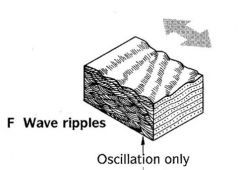
1. Differences
A. Beach ripples - Symmetrical Stoss and Lee slopes - Peaked crests - Rounded troughs - Cross laminae dip in direction of dominant current flow (onshore) |
|
|
Bidirectional Current: Oscillation Ripples in Tidal Zones
|

1. Differences
A. Tidal ripples - Symmetrical Stoss and Lee slopes - Rounded crests - Rounded troughs - Cross laminae dip in two direction i) Herringbone Structure 5. May have interference ripples if current directions are oblique |
|
|
Ancient ripple marks
|
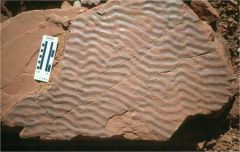
Symmtrical oscillation ripples
|
|
|
Reactivation surfaces
|

1. Dominant tidal
2. Substrate tidal (destructive) |
|
|
Common tidal bedding
|

1. Sand in troughs of muddy bedding
2. Coarse material accumulates on stoss side 3. Equal mistunes of sand and muddy beds 4. Dominant sand bedding with clay drapes (Flaser) |
|
|
Wind transported Bedforms
|
1. Mostly move by saltation
2. Large particles not transported A. Air viscosity less than water viscosity B. Accumulates as lag, desert pavement C. Coarse material on crests 3. Erosion dominates on stoss side 4. No scouring on lee side |
|
|
Differences in Water and Wind Bedforms
|

|
|
|
Bottom-of-Bed Sedimentary Structures
|
1. Flute Casts
A. Scour filled by overlying bed B. Deeper upcurrent 2. Tool mark A. Scratching underlying bed by object being transported |
|
|
Top-of-Bed Sedimentary StructuresSubaerial Environments
|
1. Mudcracks
A. Wide at top B. Curls (concave) upward 2. Raindrop imprints 3. Salt Crystal pseudomorphs |
|
|
Mud Crack Formation and Preservation
|
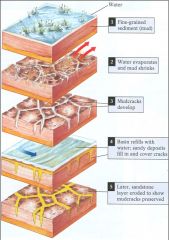
|
|
|
Mudcracks Forming
|

|
|
|
Ancient Mud Cracks Preserved
|

|
|
|
Other Within-Bed Sedimentary Structures
|

1. Graded bedding
2. Inverse graded bedding |
|
|
Secondary (Mechanical) Sedimentary Structures
|
1. Load Casts
A. Ball and Pillow B. Sand deposited on mud C. Foundering down into muddy slurry D. Bedding deformed 2. Liquefaction A. Flame Structures B. Sand moving up into overlying bed as a tongue |
|
|
Load cast
|
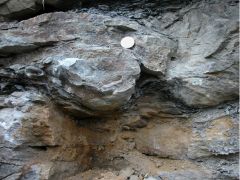
|
|
|
Mud Squeezed Up Around Ball and Detaching Ball
|

|
|
|
Load Casts Side View
|

|
|
|
Ball of Sand Foundering into Mud Without Deformed Bedding
|
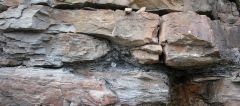
|
|
|
Deformed bedding
|
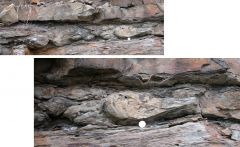
|
|
|
Ball and Pillow and Deformed Bedding
|

|
|
|
Flame Structure
|
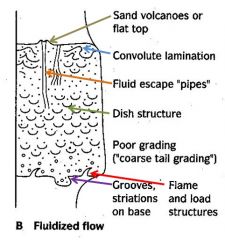
|
|
|
Biogenic Sedimentary Structures: Trace Fossils (Ichnofossils)
|
1. Indirect evidence of life
2. Used for environmental interpretations 3. Paleobythemetry 4. Paleo oxygen levels |
|
|
Biogenic Sedimentary Structures: Trace Fossils (Ichnofossils) - Burrows
|
1. Burrows into sediment for shelter and food
A. Vertical burrows B. Vertical with connecting horizontal burrows C. U-shaped burrows D. 3D network of burrows E. SHALLOW MARINE OR SUBAERIAL |
|
|
Bioturbated: Numerous interconnecting burrows
|
1. Abundant organisms
2. SLOW SEDIMENTATION RATE 3. SOIL |
|
|
Biogenic Sedimentary StructuresTrace Fossils (Ichnofossils) - Tracks
|
1. Borings into hard surfaces
A. INTERVENING SUBEARIAL EXPOSURE 2. Tracks A. Superficial horizontal burrows - LOW OXYGEN LEVEL - ABUNDANT ORGANIC MATTE - QUIET WATER 3. Foot prints A. SUBAERIAL |
|
|
Biogenic Sedimentary StructuresTrace Fossils (Ichnofossils) - Stromatolites
|
1. Stromatolites
A. domal structure B. laminated C. formed by metabolism of blue-green algae D. SHALLOW INTERTIDAL F. Precambrian (Archean – 3.5 bya) |
|
|
Absence of Trace Fossils
|
ANOXIC ENVIRONMENT – no organisms
|

